Kanto likely needs no introduction for the majority of audiophiles these days, but in case you’re new to the brand, here’s a quick refresher: based out of Canada, Kanto has been crafting high-quality, user-friendly audiophile speakers for almost 20 years. They are one of the few contemporary audio brands that seemingly predicted the future of the hobby by specializing in compact, connected speakers and subwoofers that sound great and don’t cost an arm and a leg – the perfect recipe for appealing to younger audiophiles who aren’t necessarily ready or willing to invest thousands on a separates-based system. Kanto’s product line has been expanding steadily over recent years, with the brand unveiling new speaker models of various shapes, sizes, and colors that sound far better than their price tags would suggest.
Kanto recently sent me a pair of their new Kanto REN powered bookshelf speakers (buy at Crutchfield) for review, and I was eager to see how they stacked up against other powered speakers I’ve tested in recent years. At first glance, the RENs felt quite familiar – carrying forward much of Kanto’s proven design language found in earlier models – but with some welcome connectivity upgrades and a subtly refreshed aesthetic. Each speaker features a one-inch silk dome tweeter and a 5.25-inch aluminum cone woofer, and the pair is powered by a single Class-D amplifier that delivers 100 watts RMS – plenty of juice for most living rooms, media spaces, or home offices.On paper, the REN looks like the next natural evolution in Kanto’s lineup. But do these enhancements – especially when compared to standout models like the older but legendary TUKs (which cracked the top five in our 2024 Gear of the Year List) – offer enough to justify an upgrade? Let’s answer this question and more in the review ahead.
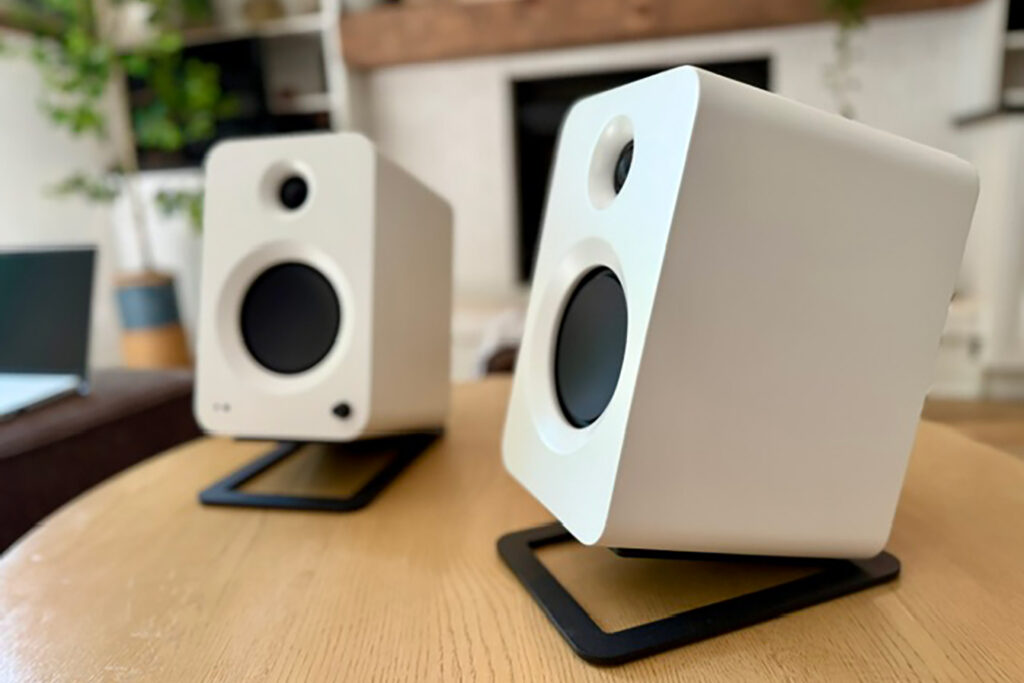
What Makes the Kanto REN Powered Bookshelf Speakers So Special?
- The Kanto REN powered bookshelf speakers feature a ton of connectivity options and are an all-in-one audio solution for those seeking simplicity without sacrificing sound quality. Kanto proudly and rightfully brags that the REN speakers are the perfect soundbar replacement, and I couldn’t agree more. Connections include Bluetooth 5.3, optical/Toslink, AUX, RCA, USB-C (24-bit/96kHz), and subwoofer out, but the star of the show is HDMI ARC with CEC, which gives users a set-it-and-forget-it solution when connecting to a TV. Kanto also thoughtfully included a powered five-volt USB charging port that comes in handy for keeping a phone or other small device topped off while working or gaming, and it can also power a streaming stick if used in a multimedia setup. It’s clear that every detail was designed with real-world users in mind, making the REN not just versatile, but genuinely practical for almost any music listening or entertainment scenario.
- Looks aren’t everything, but Kanto certainly understood the assignment, designing the REN powered bookshelf speakers to seamlessly visually blend into the listening space without calling too much attention to themselves. The Kanto REN powered bookshelf speakers, featuring an understated modern design with slightly curved-edged cabinets, are available in matte black, white, gray, orange, and blue. Whether placed on a desktop flanking a computer monitor, sitting on speaker stands, or tucked into a bedroom or den setup next to a television, the RENs can fit in anywhere. They also feature magnetic cloth grilles for those who prefer an even more grown-up and sophisticated look.
- The Kanto REN’s internal DSP does a fine job of playing to the speakers’ strengths while minimizing excessive coloration. The overall sound profile is balanced and pleasant, with treble that is never overly bright or tinny, but rather slightly veiled and mellow, presumably designed to reduce harshness or fatigue during long listening sessions. The upper midrange is more forward, which adds clarity and presence to vocals, dialogue, and instrumentation, giving the Kanto REN powered bookshelf speakers a sound profile that appeals to the majority of ears, which I assume was done to satisfy both music and home theater listeners. It’s a smart, versatile tuning that reflects the REN’s identity as a do-it-all speaker designed to thrive in the majority of listening spaces and contexts.
- Despite their modest size and weight (under 10 pounds per speaker), the Kanto REN powered speakers actually produce a decent amount of bass. I was pleasantly surprised to hear these modestly-sized beasts dip down into the low-to-mid-50 Hz range during my bass sweep measurements but, during actual music listening, bass produced by the REN’s 5.25-inch woofer was solid and clean. I did enjoy them a bit more when connected to a subwoofer, but it was not completely necessary for the majority of musical selections, especially at lower to medium volumes in my office while working.
- The Kanto REN powered bookshelf speakers come with a nicely designed, user-friendly remote control that does anything you ask of it. There’s nothing worse than unboxing a powered product only to find the remote control is flimsy, outdated, and lacking features. The REN’s remote offers full control, including bass and treble adjustments, and feels surprisingly premium in the hand. Its solid build, intuitive layout, and satisfying weight make it a fitting companion to the overall package.
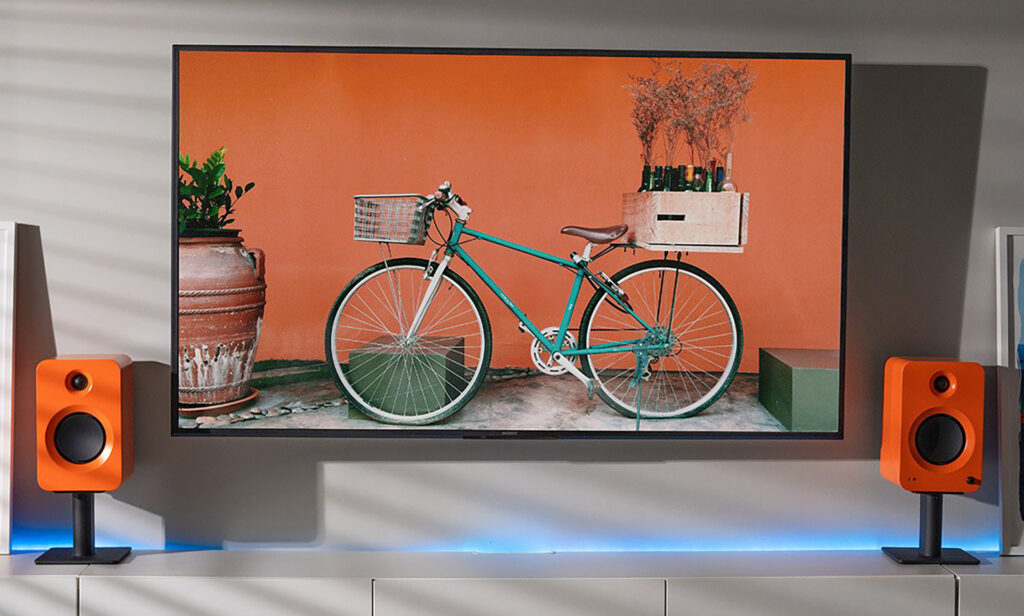
Why Should You Care About the Kanto REN Powered Bookshelf Speakers?
I’ve been following and very much enjoying Kanto’s ascension from niche audiophile company to more mainstream consumer electronics player. Their products are the darling of many YouTube and social media reviewers and “influencers,” and they have a rapidly growing online cult following. Last year, I had the pleasure of reviewing Kanto’s TUK Powered Speakers (read my review), which are hands-down some of the best-sounding in the category and a ridiculous value at their $849 price point (that price has gone up close to $100, thanks to Trump’s ill-conceived tariffs). I loved them so much that I eventually purchased a pair of smaller Kanto Ora compact desktop speakers (see our review)for my home office, and they blew away my expectations.
Some Things You Might Not Like About the Kanto REN Powered Bookshelf Speakers
- Despite their generous power rating, the Kanto REN powered speakers do not play super-loud. This might be by design, so as to limit distortion and resonance, but the REN powered bookshelf speakers did seem to be holding back a little and never got quite as loud as I would have hoped. They did open up quite a bit when connected to a subwoofer, however, which greatly enhanced my listening experience, and allowed the REN powered bookshelf speakers to reach their full potential in terms of volume and dynamic punch.
- The USB-C input on the REN powered speakers supports up to 24-bit/96 kHz playback. While that’s technically better than CD quality and still falls into the high-resolution audio category, it’s worth noting that it’s the ceiling here. For speakers in this price range, it’s a reasonable limitation and likely a non-issue for the vast majority of listeners. That said, hardcore audiophiles who obsess over every last bit and sample rate might find this minor spec limitation a little frustrating. For everyone else, though, it’s unlikely to matter or even be noticed.
- Kanto’s two-year warranty leaves a little to be desired. Kanto’s two-year warranty on the REN powered speakers is decent for a product in this price range, but could be longer. While not a dealbreaker, extending the coverage – perhaps by offering an extra year to customers who register within 30 days – could go a long way toward providing added peace of mind. For a $699 investment, that kind of gesture would reinforce confidence in the product’s long-term reliability.
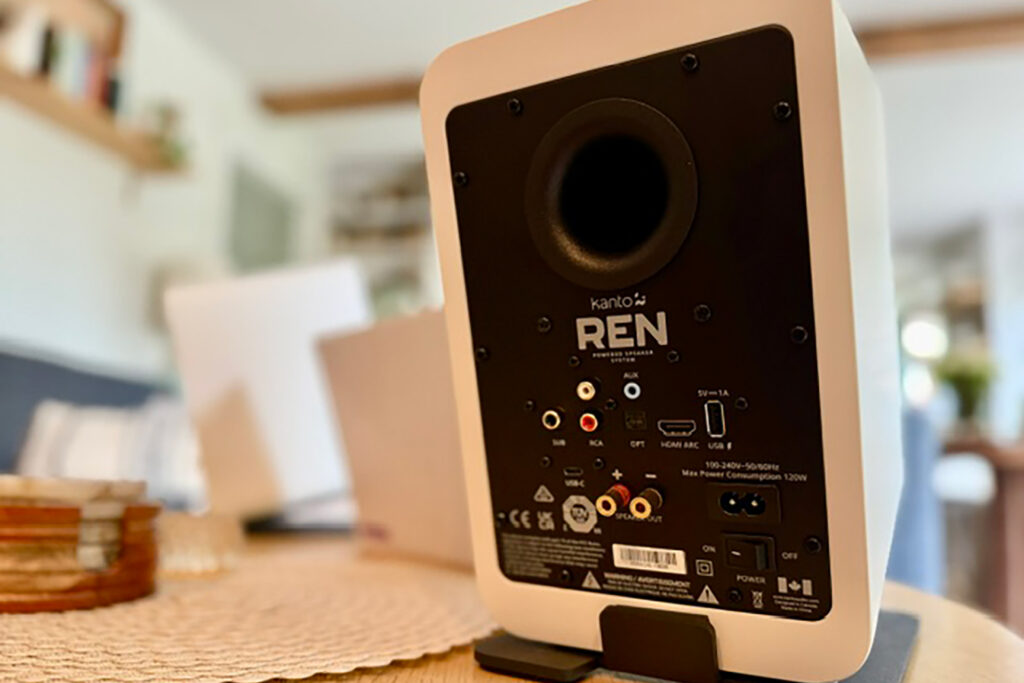
Listening to the Kanto REN Powered Bookshelf Speakers
Because the Kanto REN powered bookshelf speakers are so lightweight and easily moved, I tested them out in a variety of environments and listening spaces: on bookshelf stands in my primary listening space in a traditional two-channel HIFI configuration, on Kanto’s S6 desktop stands as monitors in my home office, and spread out about 10 feet apart in my living room on bookshelves. I enjoyed being able to stream in high resolution via Qobuz at varying volumes, heights, and locations, which gave me a better picture overall of what these speakers can do.
Lately, I’ve been hooked on the soundtrack to Ryan Coogler’s 2025 film Sinners, especially the breakout performance from 20-year-old Miles Caton, whose voice feels like it was gifted straight from the musical gods. No one that age has any business sounding this troublingly soulful (I had to double- and triple-check his age on IMDB), and I can’t wait to follow where his career goes next. On the track “I Lied to You (Radio Edit),” Caton’s gritty, expressive vocals take center stage, alongside snarling slide guitar and lush vocal harmonies. The Kanto REN powered bookshelf speakers brought this heavy blues cut to life with an impressively wide and grounded soundstage. They captured the raw texture and weight of Caton’s voice with surprising finesse. And while I wouldn’t have minded a bit more headroom at full volume, the RENs delivered more than enough power and detail to make the track shine. I found myself experiencing frisson – aka goosebumps during music listening – more than once, a reaction you simply don’t get from “average” speakers.
For contrast, I followed up with a track featuring female vocals to evaluate how the Kanto REN powered bookshelf speakers handle mid-to-high frequencies. Lizzy McAlpine’s “Spring into Summer,” a breezy, ‘90s-inspired pop tune anchored by her signature buttery-smooth, salient vocals, was a perfect choice. Right away, I was struck by the RENs’ mellow, yet articulate treble, which stayed smooth and never veered into tinny or fatiguing territory, even at the highest volumes. The internal DSP created a well-balanced presentation that was easy to enjoy but still detailed enough to satisfy my discerning ears. Adding a subwoofer took things up a notch; the REN powered bookshelf speakers’ built-in low-pass filter sends everything below 80Hz to the sub, relieving the internal amps and giving the mids and highs more breathing room, which allowed this particular track to blossom. The result was a more open and effortless sound, especially noticeable in the richness of McAlpine’s vocal tone and the surrounding instrumentation.
Will the Kanto REN Powered Bookshelf Speakers Hold Their Value?
Kanto has unofficially achieved audiophile household name status, earning a well-deserved reputation among AV enthusiasts both young and old. Their products are thoughtfully designed, well-built, and generally reliable, but let’s be honest – with their modest price tag, the RENs aren’t exactly heirloom pieces destined to be passed down through generations. Still, Kanto speakers tend to hold their value surprisingly well. Thanks to the brand’s popularity and the RENs’ versatile performance, current or prospective owners should have little trouble reselling them with minimal depreciation. These are the kind of speakers that remain in high demand, particularly among younger listeners looking to upgrade their gaming setups, dorm rooms, small apartments, or entry-level HiFi setups.
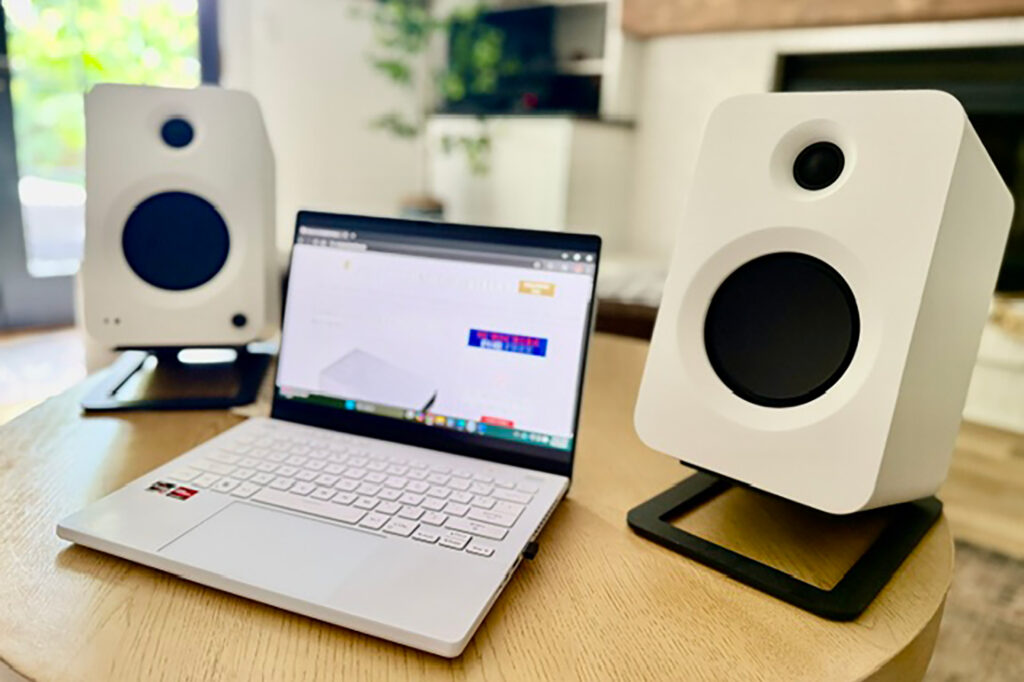
What is the Competition for the Kanto REN Powered Bookshelf Speakers?
The PSB Alpha AM5s (buy at Crutchfield) are a pair of $699 powered speakers that feature a similarly-sized 5.25-inch polypropylene mid-bass woofer and PSB’s silk-smooth .75-inch aluminum ferro-fluid cooled tweeter. The driver array is positioned in PSB’s uniquely inverted orientation, designed to improve both phase timing of the woofer and tweeter, and also to maximize high-frequency dispersion when physically placed above the listener. While the AM5s lack some of the modern touches of the Kanto RENs and do not feature HDMI ARC, PSB has a longstanding reputation as being one of the highest-quality and most accessible speaker manufacturers in the market (see my review of the excellent PSB Alpha IQ Powered Speakers with BluOS here).
The ELAC Debut ConneX series of active bookshelf speakers, specifically the ELAC DCB61s (pre-order at Crutchfield), are another compelling choice in the sub-$1,000 powered/active bookshelf speaker category. At $899, they pack a ton of technology and solid power (80 watts per speaker) into a relatively compact package. Other highlights of the DCB61 spec sheet include HDMI ARC, Bluetooth with LC3 codec, a proprietary bass enhancement system dubbed XBass, and a rear-firing “S”-shaped port for extended bass response. The driver array consists of a custom 6.5-inch long-throw mid/bass driver, which can extend down to the mid-40Hz range, coupled with a tweeter with a custom-engineered waveguide. These are coming soon, and you’d better believe I already called dibs on reviewing a pair when they do become available, as ELAC makes some of the best speakers for the money – both powered and passive.
Those looking for a slightly more affordable compact powered bookshelf speaker option might consider the $499 Audioengine HD5s (buy at Crutchfield), which feature real wood cabinets, 50 watts of Class-A/B power per speaker, Bluetooth with AptX, and a five-inch aramid fiber woofer and .75-inch silk dome tweeter. These well-reviewed speakers are available in black, white, or walnut finishes, and the HD5s are pretty hefty in their own right – 17 pounds for the left (powered) speaker and 12 for the right. While they’re not the newest option on the market, their staying power and frequent appearances on annual “Best Of” lists speak volumes.
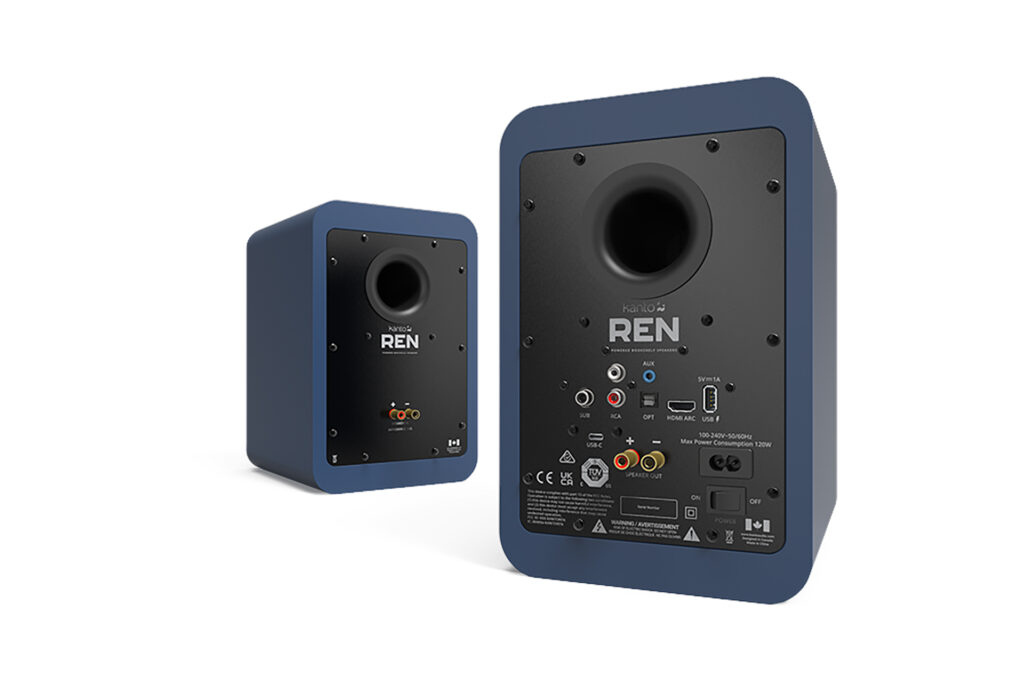
Final Thoughts on the Kanto REN Powered Bookshelf Speakers …
Kanto continues to prove to audiophiles that it doesn’t take thousands of dollars and dozens of components to achieve high-quality entertaining sound. The Kanto REN powered bookshelf speakers (buy at Crutchfield) appear to be the latest chapter in an exciting story for Kanto – one that is sure to continue and evolve within the changing audiophile landscape. Whether you’re an established audiophile seeking to add some powered speakers with HDMI ARC to a TV room, or a music lover just starting out and looking for a clutter-free, all-in-one HiFi solution that looks and sounds great, the Kanto REN powered bookshelf speakers are worth a look and a listen.



